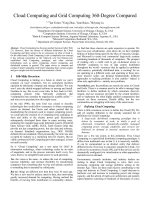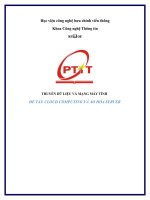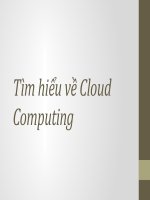assignment name cloud computing
Bạn đang xem bản rút gọn của tài liệu. Xem và tải ngay bản đầy đủ của tài liệu tại đây (1.16 MB, 24 trang )
<span class="text_page_counter">Trang 2</span><div class="page_container" data-page="2">
Contents
Introduction ... 3
Table of Figure ... 4
Detail of article ... 5
Chapter 1 Demonstrate an understanding of the fundamentals of Cloud Computing and its architectures ... 5
I. Analyze the evolution and fundamental concepts of Cloud Computing . ... 5
Public Cloud usage model: ... 6
Private Cloud usage model: ... 9
Hybrid usage model: ... 10
II. Design an appropriate architectural Cloud Computing framework for a given scenario ... 11
III. Discuss why an organization should migrate to a Cloud Computing solution . ... 12
Chapter 2 Evaluate the deployment models, service models and technological drivers of Cloud
Computing and validate their use ... 16
I. Define an appropriate deployment model for a given scenario. ... 16
II. Compare the service models for choosing an adequate model for a given scenario. ... 17
III. Demonstrate these deployment models with real world examples . ... 19
</div><span class="text_page_counter">Trang 3</span><div class="page_container" data-page="3">Introduction
ATN a Vietnamese company which selling toys is is to teenagers many provinces all over inVietnam. The company has revenue over 500.000 dollars/year. Currently, each shop has its own ofdatabase to store transactions for that shop only.
The requirement for me in this project is to find a way to meet the requirements of the ATN company which is to provide a way to store data from member shops for managers and Board members can easily and quickly reference and extract to be able to quickly update stock information in real time.
In this report I will address the following issues:
An overview of Cloud Computing through development history and related basic concepts. An architectural Cloud Computing framework suitable for the case of ATN.
Analysis and evaluation of company causes should apply Cloud Computing. Analyze and identify appropriate deployment model for ATN company. Compare service models to provide a suitable model for the company. Practical examples of the above deployment models.
</div><span class="text_page_counter">Trang 4</span><div class="page_container" data-page="4">Table of Figure
Figure 1 Cloud Architecture Layers and Related Security Issues ... 6
Figure 2 Public Cloud usage model ... 7
Figure 3 Private Cloud usage model ... 9
Figure 4 The architecture designed for ATN system ... 11
Figure 5 Application deployment diagram on the cloud diagram ... 11
Figure 6 Cost benefit of Public Cloud ... 13
Figure 7 Scalable Cloud Model. [2] ... 14
Figure 8 Environmental Protection Poster [2] ... 15
Figure 9 cloud models. [5] ... 16
Figure 10 Cloud Computing supply mode. [4] ... 17
Figure 11 AWS with Public Cloud. ... 19
Figure 12 Explore of AWS Products... 20
Figure 13 Oracle with Private Cloud. ... 21
Figure 14 Cisco Hybrid Cloud Platform for Google Cloud [10] ... 22
</div><span class="text_page_counter">Trang 5</span><div class="page_container" data-page="5">Detail of article
Chapter 1 Demonstrate an understanding of the fundamentals of Cloud Computing and its architectures
I. Analyze the evolution and fundamental concepts of Cloud Computing . Defi e:
Cloud Computing: “Cloud computing is the on-demand availability of computer system resources, especially data storage and computing power, without direct active management by the user. The term is generally used to describe data centers available to many users over the Internet. Large clouds, predominant today, often have functions distributed over multiple locations from central servers. If the connection to the user is relatively close, it may be designated an edge server.” [1] Benefits and limitations:
Flexibility: easily access data anywhere with fast and stable speed.
Productivity: save time (no need to set multiple layers of security and firewalls, …) Limitations:
For large companies, important information stored at a third company can lead to risks despite high reputation and security services.
With important data, large companies often have their own IT departments to store and protect. Ability to control restrictions on functions and ways of operation.
Cloud ecosystem: includes interactive and responsible individuals and organizations with cloud services.
Cloud service provider (CSP): providing, managing, maintaining cloud services (Serverless computing, Platform as a service (PaaS), Server computing, Software as a service (SaaS), etc). Cloud service users (CSP): are individuals and organizations that use cloud services
Cloud service partner (CSN): As individuals and organizations providing support for the construction of CSP cloud services (application development, software, hardware, ...)
</div><span class="text_page_counter">Trang 6</span><div class="page_container" data-page="6">Cloud architecture: Include 4 layers: user layer, Service provider layer, virtualization layer and physical layer
Figure 1 Cloud Architecture Layers and Related Security Issues. Applications on the Cloud:
A stand-alone application: standalone applications running on the system, not using the network => perform the functions of the application.
Web application: run, perform functions completely based on network connections. Types of cloud computing:
Public Cloud Service: provided by third parties (Microsoft azure, Amazon web service, ...) Private Cloud Service: Built and used by a company.
Hybrid Cloud Service: a combination of the above two types through application, interconnection system makes moving applications between clouds happen quickly and easily.
Public Cloud usage model:
</div><span class="text_page_counter">Trang 7</span><div class="page_container" data-page="7">Figure 2 Public Cloud usage model.
In order to push data to the cloud part assigned by the system, the shops will have 2 ways to use it. The first way is to use the built-in web interface to be able to directly perform tasks for data (add, edit, delete,
</div><span class="text_page_counter">Trang 8</span><div class="page_container" data-page="8">view) via the provided ID shop. In case the website has a problem or a network connection error, the shop can use the second way, which is to push the data into Primary App to perform the same tasks as when using the web and when connecting properly Primary app will work to automatically push all data entered offline through the provided ID shop.
From here the data from the shops will be managed on the available cloud partition. Next, periodically App for Cloud will take data from the cloud partition of the shop to aggregate data to upload to the main cloud (Database of all shops). It also has functions such as viewing data and collating data with an existing database to avoid duplication and confusion, or wasted storage space.
</div><span class="text_page_counter">Trang 9</span><div class="page_container" data-page="9">Figure 3 Private Cloud usage model.
Private Cloud usage model:
Here, after senior managers or the board of directors gets data from Database of all shops, they can extract these data to conduct analysis and evaluation (can use Business Intelligence tool to Support implementation quickly and get the most intuitive reports).
And from there they will create important data to be able to assess the status quo and set out future plans (this is also one of the most important and confidential data needs).
After these important data are created, the administrators can perform tasks such as adding, editing, deleting and viewing these important data to the Important Data Server. This will be a place with high-security requirements because it contains a lot of confidential and important data for the company.
</div><span class="text_page_counter">Trang 10</span><div class="page_container" data-page="10">Hybrid usage model:
The model will be a combination of using Public Cloud (used to manage the database of shops) with Private Cloud (used to manage important data of the company) by App to manage with access rights of managers or members of the board of directors to view and extract data in Database of all shops for reference or as a basis to use in analyzing with BI tools.
Figure 5 Application deployment diagram on the cloud diagram. Above is the application deployment diagram on the cloud diagram.
The deployment of the application to the cloud was built independently on PC / Laptop locally by Visual Studio 2019 and will then use XAMPP to create a web application on Localhost. Finally, we use GIT to push it to the HEROKU cloud and open it in the cloud.
During the deployment process, the user interface (Front-end) will be deployed in the PHP programming language, towards the Back-end (database array) will be applied and deployed in the language SQL server.
</div><span class="text_page_counter">Trang 11</span><div class="page_container" data-page="11">II. Design an appropriate architectural Cloud Computing framework for a given scenario
Figure 4 The architecture designed for ATN system.
Above is a diagram describing my demo cloud architecture for ATN company built on the Hybrid Cloud model. In particular, the combination of Public Cloud (serving the need to upload and manage sales database of child stores under the ATN company) with Private Cloud (serving the needs of synthesis and management) important information of ATN company).
Going into details, I will conduct an analysis of each section so that people can understand more about how this system works.
Figure 5. Application deployment diagram on the cloud diagram
</div><span class="text_page_counter">Trang 12</span><div class="page_container" data-page="12">1. Architecture description 1.1 Main architecture design
- All of users can access to the web application via the User Interface on the cloud When a user. does a function on the web, the event will be transferred in database language and sent to the database.
I chose PHP because PHP is good to build the connection between webserver and database as well as support querying data from webserver to database and reverse. While HTML, CSS, and JavaScript can built the body of the page
2.2 Web server
I chose APACHE because:
The web server itself uses a modular architecture, in which extra modules can be loaded to extend its features
Apache Web Server is open source software, which means it is available for anyone to download at no cost.
Technical support resources for Apache are available on multiple websites around the world.
2.3 Database server I chose MySQL because
Data Security High Performance
The Flexibility of Open Source 2.4 Deployment model
I chose public cloud because ATN is a small company. As a public cloud user, you aren’t responsible for managing your cloud hosting solution. Your cloud service provider is responsible for the management and maintenance of the data center in which your data is stored
2.5 Service model
I chose infrastructure as a service because it scalable and cost effective, with a small company like ATN it very important. It also save money on server because when you use it you don’t need to spend money on physical servers and network resource
III. Discuss why an organization should migrate to a Cloud Computing solution . Ben its of Cloud Computing: [2]
Simple:
All applications for employee data needed are stored in the cloud.
IT team does not have to spend time upgrading hardware, installing software and configuring the device.
There is no time for finding or transferring data for the same department.
</div><span class="text_page_counter">Trang 13</span><div class="page_container" data-page="13">Allow to simultaneously upgrade programs and applications of everyone in the company and always work together on a common platform and version.
Easy to access Internet platform:
Employees can work almost anywhere (with an Internet connection). You can use a variety of devices to access (phones, tablets, laptops,
...) without being dependent on physical settings. Security for important data:
Data will be stored digitally in the cloud infrastructure, avoiding loss of faulty data or hardware. Easy access to data recovery and backup to avoid losing important data.
There are many Cloud system providers that have very good and reliable privacy and security encryption services.
Use cost effectively: [3]
Figure 6 Cost benefit of Public Cloud.
The technology upgrade requires the company to pay for the purchase and installation of hardware compatible with the original system (the amount of the cost depends on the size of the company).
</div><span class="text_page_counter">Trang 14</span><div class="page_container" data-page="14">There is no cost to upgrade the original device (desktop, connected device, related software, etc.).
There is no cost to set up a team to operate and test the system on a large scale. With the same model using cloud computing, it will save a lot of costs (about 30% or more). You can hire a third party or create your own system and run it yourself.
For the resources that have been rented but not used (low demand), customers do not have topay.
Efficient use of resources:
Resources are always used appropriately according to customers' needs.
Virtualization technology helps to exploit physical resources effectively, serving more customers. Cloud Computing distributes resources in a Multi-tenant fashion - resources can be dynamically
distributed to many different customers (alternate use). Can be recovered and allocated to customers with other needs if resources are no longer needed. Help prevent unused resources from becoming redundant and confusing for storage.
Bring flexibility to businesses:
It is easy to scale up because it does not depend too much on hardware facilities.
Can quickly increase configuration, storage capacity and support from IT staff without having to be present directly.
Figure 7 Scalable Cloud Model.
</div><span class="text_page_counter">Trang 15</span><div class="page_container" data-page="15">Increase cooperation and business validation:
When enterprise expansion, increased collaboration and validation capabilities, cloud computing systems make it easy to share data and not restrict hardware collaborators (freelance or regulatory companies). Smaller tissue, ...).
Cloud computing system helps managers can easily and quickly manage the amount of data newly received from partner companies.
Environmental Protection:
Figure 8 Environmental Protection Poster [2]
</div><span class="text_page_counter">Trang 16</span><div class="page_container" data-page="16">Developers research efficient use of resources (using electricity, recycling, ...).
No need to spend resources on initial equipment investment, minimize the amount of technology waste after use, upgrade, maintenance, or after finishing work.
Save energy when not running a large system.
Contribute to the greater goal of society on energy efficiency, environmental protection and sustainable development.
Minimize the risk of investing in the technical system. 24x7 system / service monitoring.
Chapter 2 Evaluate the deployment models, service models and technological drivers Cloud ofComputing and validate their use
I. Define an appropriate deployment model for a given scenario. Reference content at: [4] [5]
Before entering into recommendations choosing appropriate deployment models for ATN oncompanies, we need to know about the advantages and disadvantages of each type. Currently, Cloud computing is a trend and the deployment model currently has 3 main types: Public Cloud, Private Cloud and Hybrid Cloud. Now we will go into details of each type of model.
Figure 9 cloud models. [5]
Con usions and recommendations:
After all, each model will have its own characteristics and advantages and disadvantages as I mentioned above. But for the case of ATN company, I propose to use Public Cloud model because of the flexibility use and the ability expand the scale the company in the future and the in to ofnumber of costs appropriate to current income. and respond immediately the company to to be able to take initiative in the stock market to bring great benefits to the company in the future. The allocation of the use of small models in the process of use I also have the following recommendations: the stores will proceed to push their data to the Public Cloud system so that the
</div>








